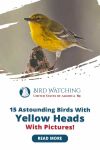
What’s This Post About?
Did you come across a yellow bird during your birding experience? Or are you wondering what stunning little yellow bird was grazing around in the backyard, twittering its wings rapidly, during your morning stroll?
Well, there are a plethora of brilliantly colored yellow birds out there, with splendidly contrasting hues of colors across the spectrum. While some have an overall yellow plumage, some may be partially yellow.
There are many birds with yellow heads. Some popular ones include Yellow-headed Blackbird, Yellow-throated Vireo, American Goldfinch, Evening Grosbeak, Pine Warbler, Yellow Warbler, Wilson’s Warbler, Hooded Warbler, Prairie Warbler, Blue-winged Warbler, Prothonotary Warbler, Western Tanager, and Hooded Oriole.
What are the Spectacular Yellow-Headed Birds in my Backyard?
Yellow birds may not always have the brightest of yellows on their heads. If you pay close attention, you'll note some might have a duller yellow crown on the head, while others have a strikingly flaming orangish-yellow head.
If you’re contemplating what these astounding yellow-headed species that you perhaps just spotted in your backyard could be, adding an impeccably ornamental touch to the natural environment, continue to read on.
Let’s get onto discovering an array of yellow-headed species that may make their way into your backyard.
| Names | Scientific Names |
|---|---|
| Yellow-headed Blackbird | Xanthocephalus xanthocephalus |
| Yellow-throated Vireo | Vireo flavifrons |
| American Goldfinch | Spinus tristis |
| Evening Grosbeak | Coccothraustes vespertinus |
| Pine Warbler | Setophaga pinus |
| Yellow Warbler | Setophaga petechia |
| Wilson’s Warbler | Cardellina pusilla |
| Hooded Warbler | Setophaga citrina |
| Prairie Warbler | Setophaga discolor |
| Blue-winged Warbler | Vermivora cyanoptera |
| Prothonotary Warbler | Protonotaria citrea |
| Western Tanager | Piranga ludoviciana |
| Hooded Oriole | Icterus cucullatus |
| Lesser Goldfinch | Spinus psaltria |
| Townsend’s Warbler | Setophaga townsendi |
1. Yellow-headed Blackbird
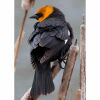
The bold, plump bird has a golden yellow head, and a slight white patch on the wings, with an overall black body, quite easily detectable in its surroundings. The male bird has a striking appearance, quite likely to catch your attention as the bird visits your backyard, to forage onto the seeds and grains, usually gliding in huge flocks of blackbirds.
The female has a relatively dull color, with blackish-grey plumage. Inhabiting the wetlands and marshy areas, the birds are commonly found alongside shallow ponds and riversides as well as wet farm fields. You are likely to recognize the conspicuous bird with its raspy and harsh songs - quite unpleasant to hear.
Watch out for its peculiar grinding and buzzing sounds as the bird perches onto the trees. The gregarious species often nest in colonies, usually flying around in massive flocks during the migration period. Characterized as mid-sized, the adult bird is around 9 inches long with a wingspan of around 15 inches.
Look out for the key features:
- Size is around 9-10 inches
- Pointed bill
- Primarily black with yellow head and breast
2. Yellow-throated Vireo
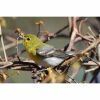
Quite tiny in size, the bird has an olive-yellowish head, brightening in hues at its throat. From afar, the bird seems like it’s wearing bright yellow spectacles. Having a greyish brown plumage with slight white streaks, and a white belly, the vireo is considered to be one of the most colorful birds in its family.
Inhabiting the deciduous forests otherwise, the little bird can be spotted around hopping on the edges and canopies, as it feeds onto the insects in the tree branches and twigs. Spot the stout bird swinging on the tree branches as it incessantly sings its burry songs.
Relatively subdued in nature, hear closely to listen to its raspy ‘three eight’ tune.
Look out for the key features:
- Size is around 5-6 inches
- Stout bill
- Yellowthroat and spectacles with an olive plumage
Did You Know?
They are generally quite social birds, so you would quite often see them in pairs or flocks rather than perching alone.
3. American Goldfinch
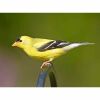
Prevalent throughout America, this conspicuously bright yellow bird is a common sight in backyards and bird feeders. Look out for the bird as it forages in the weedy fields and cultivated areas and perches onto the electrical wires and tree branches on the roadsides.
Males are easily recognizable due to their brilliant yellow color with black wings and forehead. Lacking the flamboyance of its male, the female is dull yellow with grayish olive wing bars.
The stocky little bird is quite active and lively as it hops around with its charming features, singing its musical warbles and twitters with a tsee-tsi-tsi-tsit call. Usually flying with other birds of its kind, the gregarious bird is often seen flying around in huge flocks.
In your birding spree, you’re likely to find plenty of the Goldfinches near areas with thistle plants and bird feeders. Seeds like sunflower, nyjer, dandelions as well as berries, and tree buds majorly constitute the diet of the vegetarian bird.
Look out for the key features:
- Size is around 5 inches
- Small, conical beak
- Bright lemon-yellow plumage
4. Lesser Goldfinch
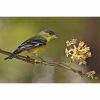
A rather tiny finch, varying in hues of yellow and green with long black wings and a short-notched tail, it is prettily streaked with white wing bars. Notice the black patch on the small head of the finch, helping you to distinguish the bird from other finches.
Inhabiting the scrubby oaks, cottonwood, and willow habitats of the region, look out for the tiniest of finches in the treetops of the tall trees. You might catch a glimpse of the bird clinging onto the thistle plants pecking onto its feed. Quite a common visitor at bird feeders and backyards, the bird can be found perching around in the weedy fields, shrubs, and trees around. Flying in flocks at least six birds, the finch primarily feeds on seeds.
Though tiny in size, the bird has high pitched, harsh whistling calls sounding like ‘chig chig chig’ and chanting wheezy songs with prolonged twitters, often imitating other species around it, making it easy for birders to detect it.
To attract finches to your backyard check out these , bird mixes comprising feeds of finches’ preferences.
Look out for the key features:
- Size is around 3.5 to 4.5 inches
- Mottled back and cap - black to green
- Bright yellow underparts
Did You Know?
Lesser Goldfinch is known to be the smallest true Finch in the world.
5. Evening Grosbeak
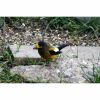
A relatively large bird, almost twice the size of a goldfinch, has a strikingly stunning appearance, with the charmingly stout and heavily built body, ranging in tones of bright yellow to grey.
The male has a stunning yellow color extending from its forehead to the lower body, with dusky grayish-black wings, streaked with white patches. The female version has subtler tones, having a primarily olive-grey plumage with golden highlights.
Inhabiting in the coniferous forests, you might be able to spot the chunky finch once in a while in your backyard, most likely in the winters, as it might land at nearby bird feeders. Preferring to forage high up in the trees and bushes, it usually feeds on insects, berries, and seeds.
Not too loud, the bird prattles in incessant burry calls. Enjoy a thrilling bird-watching experience as you spot the noisy bird on higher elevations as it glides around in flocks, with their sweet and sharp call notes.
Look out for the key features:
- Size is around 6-8 inches
- Short black tail and wings, and large pale bill
- Bright yellow forehead and body
6. Pine Warbler
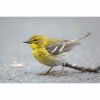
Rightly named, the pine warbler is an inhabitant of Pine Forests, hopping slowly on the tree branches and trunks poking the pine cones with its vigorous bill.
A mid-sized, robust bird, the male has grayish olive plumage with two distinct white wing bars and a bright yellow throat extending to its underbody. The female has a rather dull, grayish-brown plumage with diffused streaks of yellow.
Listen to the bird’s running patter of musical notes, as it forages deep in the tree foliage. Its calls are quite similar to the Chipping Sparrow and the Dark-eyed Junco, so don’t be confused and look out for the stout bird with its long narrow tail and sturdy bill.
Peculiar to its family of warblers, it is the only bird among its species that majorly feeds on seeds. The vivacious bird grazes seeds, millets, corns, and peanuts both from the ground as well as elevated feeders. You might also spot the bird foraging fruits such as berries and grapes in the bushes and shrubs.
Look out for the key features:
- Size is around 5-6 inches
- Yellowish lines on the eyes
- Bright yellow throat and breasts
7. Yellow Warbler
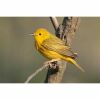
A radiantly colored, yolky yellow bird, the warbler is a widespread species cruising around, from the Northern to the Southern states. An alluringly captivating species, the warbler has a bright buttery color overall with slight reddish-brown streaks edging the tails and wings.
The female typically has a paler yellow plumage, lacking the peculiar chestnut streaking of the males, but its bold black eyes are a striking feature on the otherwise unmarked face.
Preferring to forage in bushy and marshy habitats, look out for the stocky bird in thickets, streamsides, and wet woods. It feeds mainly on insects, acquiring its prey from the plantations and capturing the flying insects. Small juicy fruits such as berries are also a part of the Warbler’s diet.
Watch out for the tiny bird perching in bushes and branches of smaller trees, fairly low to the ground, where you can hear its tumbling whistle calls ‘sweet sweet sweet’.
Look out for the key features:
- Size is around 4-7 inches
- Greenish golden upper body and bright yellow lower body
- Rusty streaks on flanks
8. Wilson’s Warbler
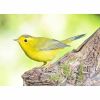
A rather tiny bird, one of the smallest in the country, the Wilson Warbler adorns a bright yellow color with a black crown patch on the head. Notice the greenish-brown wings and narrow long tail of the warbler as it flutters rapidly in the air.
Hard to detect in the dense vegetation due to its minute size, the robust and active bird sprints between shrubs, catching insects amidst the dense foliage. Feeding primarily on insects, the jaunty forager catches bees, caterpillars, and beetles gleaned to the leaves and ground.
You might spot the bird perched on the lower twigs of the tree as it sings its rapid chattering songs with a raspy and coarse voice. Usually inhabiting the mountains, forests, and wooden habitats, as well as wet shrublands, the enchanting yellow warbler prefers to live in dense thickets, especially with willows and alders.
Look out for the key features:
- Size is around 4-5 inches
- Small black crown patch
- Bright yellow head and underparts, green-brown back
9. Hooded Warbler
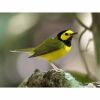
A relatively small, yellow bird that flicks its tail frequently to exhibit its white tail feathers. The boldly conspicuous bird has bright yellow cheeks and a prominently shaped black hood on the forehead, distinguishing it from the other warblers of its family.
The female hooded warbler has subtler hues of olive-green plumage, yellow underparts with an olive-green cap. Dashing around rapidly, habitually flashing its feathers, the warbler tends to reside in mature forests with well-developed understories and wooded swamps.
You might spot the bird hanging out in the shrubby areas amidst the trees if you have one in your backyard. Listen carefully to the chinking musical notes of the warbler in the lower vegetation regions as it makes the shrilling “weeta-weeta-weeTEEyoo” call.
Look out for the key features:
- Size is around 5 inches
- Distinctive black hoods surrounding yellow faces
10. Praire Warbler
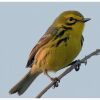
A small plump bird, with a typically yellow body, is refined with black streaks on the wings and tail, with a slight reddish patch on the back, which is rarely visible. Note the peculiarly patterned face of the bird which has dark lines surrounding the eye.
Wagging its long tails frequently, the bird resides in brushy areas, scrubby fields, and forest regions. Majorly consuming insects as a source of food, the pygmy bird forages vigorously from one tree branch to the other as it gleans the insects.
Singing songs with variable pitches, the song A sung by the bird has a higher pitch with ascending buzzy notes, while song B is a longer whistled note with rapid check calls. While the Prairie usually directs Song A to its female companion, song B is often sung at the territorial boundaries of the bird, or when there is a fight between the males, to chase them away.
Look out for the key features:
- Size is around 4-5 inches
- A black line through the eye, and a yellow spot underneath it.
- Dark rusty streaks on the wing bar
11. Blue-winged Warbler
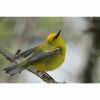
The strikingly flamboyant bird, with an overall yellow plumage, intricately contrasts with blue-gray wings and subtle white wing bars. The male species is astoundingly more attractive than its female, with a brighter plumage. Notice the sleek black line running through the tiny bird’s eye.
Its peculiar raspy buzzing notes, making sharp chips in the atmosphere, are key to identifying the bird in the dense shrubs amongst many of its kinds. Typically found in brushy and scrubby fields, the warbler flaunts its dazzling plumage.
Trotting from branches and leaves, hanging upside down, as well as foraging at the edges of thickets and fields, the bird gleans the insects.
Specifically, during the migration season, watch out for the warbler dashing around in the nearby gardens and parks, or perched at elevated powerlines or branches of tall trees as it sings its distinctive bee buzzing chorus.
Look out for the key features:
- Size is around 4.5 - 5 inches
- Bright lemon-yellow head, breasts, and underparts
- Bluish gray wings
12. Prothonotary Warbler
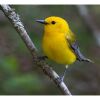
The conspicuously bright yellow bird, sometimes known as the swamp warbler, prefers to live in moist habitats like swampy forests and forested wetlands.
A relatively small warbler, the bird has a predominantly yellow body, with hues of olive on the back, and blue-grey wings and tail. The female is quite subtle with duller yellow plumage, unlike the brightly colored male. The plump bird has a short, wide tail, and note its beady eyes as they stand out on the round face.
The strikingly charming bird sprints around tree branches, displaying its conspicuous plumage, fluttering its wings like a golden ray of light in the dark understories. When you reach their habitat, search for golden flashlights flickering in the lower shrubs of bottomland forests, where it typically resides.
Feeding mainly on insects and snails, it forages robustly in the lower foliage. Listen for the bird’s loud, coarse ‘tsweet tsweet’ call, as it piercingly rings in the ears.
Look out for the key features:
- Size is around 5 inches
- Bright orange-yellow head and yellow underparts
- Olive plumage with blue-grey wings
Did You Know?
Prothonotary Warbler is only one of the two warblers that nests in cavities - the other being Lucy's Warbler.
13. Townsend’s Warbler
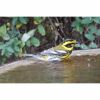
The brilliantly colored tiny warbler with a yellow face and a coal-black stripe extending up to the ears enables to distinguish the warbler from more of its species. A yellowish olive plumage, with sophisticated black streaks on the back and flanks, the stout bird often blends itself in the mixed flocks of other warblers and smaller songbirds like itself.
Preferring habitats with dense foliage and vegetation, such as coniferous forests, look for the birds in the elevated trees, nesting and foraging higher in the canopies. These tiny, enchanting creatures may not be quite easy to spot in the treetops.
Dashing around from branches to leaves, the bird captures its food by gleaning the insects on the foliage and even hawking the ones in flight. The enchantingly buzzy songs with a zee zee zee bzz zee melody add to the beauty of the atmosphere.
Most likely to be visible during the winter, when the songbird forages in any well-vegetated regions around, allowing you to catch a glimpse of it easily even in small trees and shrubs. Frequently visiting bird feeders, the bird usually comes in flocks to feed on mealworms, peanut butter, and berries.
Explore the vast range of bird feeders suitable for warblers that you can place in your backyards and enjoy a delightful view as the songbirds stop by.
Look out for the key features
- Size is around 4.5 - 5 inches
- Blackcap and black throat
- Patterned yellow face with a black stripe on the cheek extending till the ear
14. Western Tanager
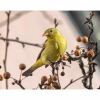
If you’ve taken a close look at this tanager, you know how the robust bird looks like a sparkling flame. A brilliantly bold bird, with a blazing orange-yellow head, yellow underbody, and coal-black plumage, tail, and wings, not to forget the two white wing bars on the side, giving the bird a stunning appearance.
The females are somewhat dimmer, however, in hues of greyish green with a dull yellow face. Preferring to nest and breed at higher elevations, the flamboyant bird can be found in the coniferous and mixed forested regions and dense Woodlands, hiding under the tree canopies.
Despite the brilliantly bright colors, the bird can be hard to detect so watch out for it on the treetops carefully as the bird perches itself on the higher branches. Singing its loud, rusty songs, with an ascending and following melody of two to four notes, the bird often glides around in flocks of few.
During your birding venture, you might hear the chuckling rattle calls of the bird near the trees.
Look out for the key features:
- Size is around 6-7 inches
- Flashy flaming appearance
- Bright Orangish yellow head-turning lighter along the neck, with black wings
15. Hooded Orioles
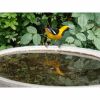
A mid-sized bird with a slender body, with an enchanting coal-black contrasted with flashy orange-yellow, the hooded oriole is often seen flying high up in the sky near the open Woodlands and shrubbery.
The male has a black mask and throat and black wings and tail elegantly streaked with white feathers. The females have a paler yellow body with a grayish wash on the upper body.
You might catch the glimpse of the bird quite often in the neighborhood and nearby parks, as it perches on the trees, having an inclination to palm trees. Lend a close ear to listen to the chattering calls used as an alarm and rapid, gruff songs, often sounding whiny.
Relatively inconspicuous to spot, the bird forages slowly while staying hidden in the trees. Visiting the bird feeders often, the bird is attracted to insects, fruits, and nectars.
In the open yards and woodlands, the oriole sews its hanging nests on the undersides of the palm leaves. Note its awkward drinking practice as the bird hangs upside down to drink water.
Look out for the key features:
- Size is around 6-7 inches
- Flashy flaming appearance
- Bright Orangish yellow head-turning lighter along the neck, with black wings
Keep Reading!
Seeing a yellow-headed bird in your backyard is not rare, as the frequent visits of the birds add vibrancy to your environment. From the many yellow-headed birds, a few that you might notice include Yellow-headed Blackbird, Yellow-throated Vireo, American Goldfinch, Evening Grosbeak, Pine Warbler, and Yellow Warbler.
Now that you’ve explored a vast array of species having yellow heads and even a yellow plumage, ranging in hues of flashy orange-yellow and bright lemon to subtler tones of pale yellow, it is much simpler to identify each bird with its distinctive features.
If you wish to capture these yellow beautiful birds in a frame, you can read our blog on backyard bird photography to learn more. We are sure you would love the photographed results!
Backyard Bird Photography: Essential Gear for Beginners - Here is Your Expert & Exciting Guide!
Here’s your expert and exciting guide to set you on course for a captivating photography experience. Backyard bird photography just got better, learn how!

By David A. Swanson
Bird Watching USA
My name is David and I'm the the founder of Bird Watching USA! I started Bird Watching with My father-in-law many years ago, and I've become an addict to watching these beautiful creatures. I've learnt so much over about bird watching over the years that I want to share with the world everything I know about them!

David A. Swanson
Bird Watching USA
My name is David and I'm the the founder of Bird Watching USA! I started Bird Watching with My father-in-law many years ago, and I've become an addict to watching these beautiful creatures. I've learnt so much over about bird watching over the years that I want to share with the world everything I know about them!



